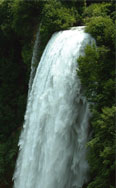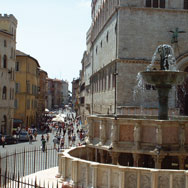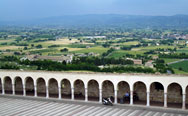- Villa search

- Canaries
- Caribbean
- Croatia, Bulgaria and Hungary
- Cyprus
- Florida
- France and Corsica
- Greece
- Italy
- Lakes and Mountains
- Madeira
- Malta and Gozo
- Portugal
- South Africa
- Spain - Balearics
Information

Lake Piediluco
Lake Piediluco is a natural lake surrounded by wooded hills – its name means ‘at the foot of the mountain’. A settlement of low whitewashed houses stretches between the waterfront and the slopes. Cobbled alleyways slant down to the water’s edge, often with a boat moored at the bottom. There’s a 13th century church with ancient frescos, and a ruined 14th century fortress. In the piazza we passed a huddle of men playing cards at a table.
By the lakeside we unearthed a gem of a restaurant, Ristorante Eco, where we ate trout from the lake while gazing at the fantastic view across the waters to a wooded mountain, Caperno, in the shape of a perfect cone.

Marmore Falls
The nearby Marmore Falls were an important stop on the European ‘Grand Tour’ undertaken by the privileged of Europe and America in the 1800s and late 1700s. The 540ft falls were created by the Romans. In 290BC Curio Dentato ordered a canal to be dug to divert the stagnant Velino river over the cliff at Marmore and into the River Nera below. The result is a crashing pillar of water among wooded cliffs, and it’s been an inspiration to artists and poets for centuries.
Nearby are the ruins of the Roman town of Carsulae. A road called the Flaminia Way was built in around 220BC by censor Caius Flaminius to ease travel between Rome and the Adriatic Sea. Carsulae – in a beautiful location – prospered as a stopping point. A footpath takes you through a poppy field and woods to a visitor centre containing finds from the site. Outside, the paving stones of the Flaminia road are still clearly visible, and various public buildings, including temples, a forum, amphitheatre and an enormous archway can be explored.
Perugia, the region’s capital, is in yet another dramatic hilltop location, overlooking a lovely landscape. The old city is surrounded by massive walls built by the Etruscans between the sixth and third centuries BC. Seven gates allow access, the largest of which is the mighty Etruscan Arch.

The 12th century fountin in Perugia
Steep alleyways wind between six-storey buildings – some with washing hanging from balconies – leading up to the Piazza IV Novembre, one of the most beautiful squares in Italy. It’s edged by wonderful buildings including the Cathedral of San Lorenzo and the Palazzo dei Priori, which houses the National Gallery of Umbria. Next door is the Sala del Collegio del Cambio, its walls and ceilings covered in frescos by Perugino – among the most impressive examples of Renaissance painting in Italy.
The sunny square was buzzing but not heaving – many people were sitting on the cathedral step looking over the Fontana Maggiore, a 12th century fountain. You could spend much time perusing the shops, but we strolled to the end of the square and the marvellous views of hills – green and yellow; houses – red and white, and mopeds by the dozen on the road below.
About twenty minutes’ drive west of Perugia is Lake Trasimeno – well worth a visit. Goethe said of it in 1786:
‘The view of the lake is truly a delight: those sights are now well engraved in my mind's eye.’

View from the Basilica of St Francis in Assisi
East of Perugia is Assisi, of St Francis fame. The centre of attention is the Basilica of St Francis, built between 1228 and 1253. It looks beautiful from the outside – yet is even more so inside. Hard to achieve, but if anyone could make this possible, then Giotto, Cimabue, the Lorenzetti brothers and Simone Martini could. They were among the greatest painters of the 13th and 14th centuries. Perhaps the most famous section is the Upper Basilica, adorned by Giotto's frescos illustrating the life of St Francis. The stained glass windows by Giovanni di Bonino and Puccio Capanna are also especially beautiful. For many, though, the highlight is a visit to the saint’s tomb in a crypt below the Lower Basilica – a moving experience, even if you’re not a ‘believer’.
On our penultimate night, our hosts at the farm told us the nearby village of Farnetta was having a celebration, the Festa di San Rita – a party for the local saint of impossibilities. The village teemed with people, and the hub of activity was a school hall and sports court, which a whirlpool of dancers had taken over, stirred by the live music. First we ate supper – I had delicious vegetables in batter – and then we took to the court. Anonymous among the mass of dancers, our moves were rough to the core – appropriate at a festival celebrating the impossible. It was a fun-filled evening – the people of Umbria are friendly, warm, and welcoming. Having such a lovely place to live in, you can understand why.
home | destinations and editorial | villa search | property for sale | car hire | flights | services
villaseek blog | contact villaseek | links and resources | advertise your villa© Dune Root Ltd and Villaseek.com 2012 - Caribbean
- Canaries